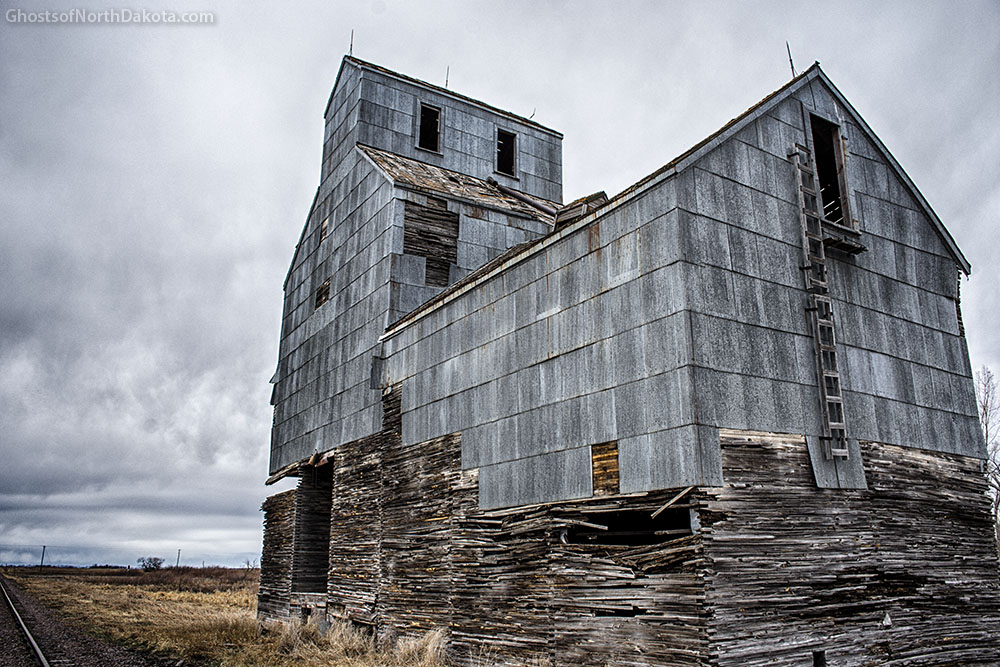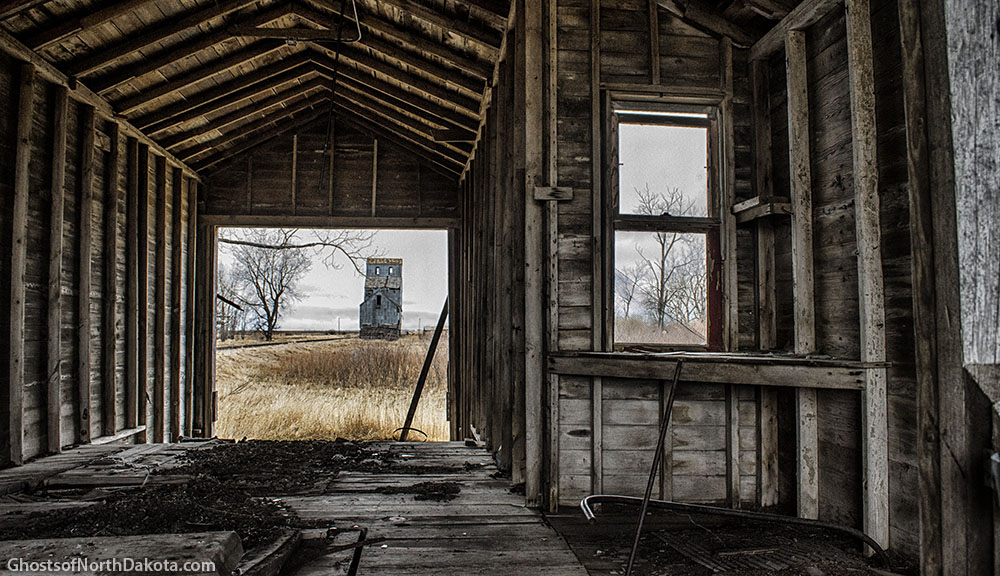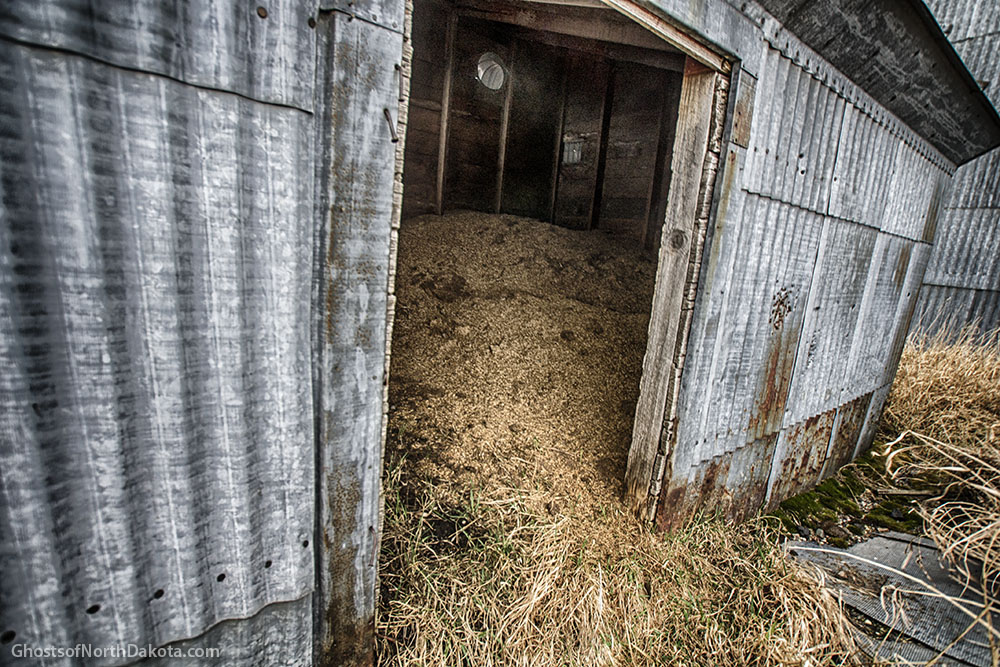Once upon on a time there was a pioneer settlement named Genin at this spot in Benson County, about halfway between Maddock and Oberon, North Dakota. That settlment was later renamed Josephine, but it never really became a town. The highest population ever recorded was approximately 30, and some of those were folks who lived in the surrounding countryside. The truth is, Josephine was really just a glorified railroad siding along the Northern Pacific Railroad. The remains of the town are gone, and only two crumbling grain elevators remain.
We visited Josephine once before at the suggestion of one of our site visitors, but on that day, it was about two minutes ’til winter, and there were 40 mph wind gusts blowing, so we took some photos from a distance, but didn’t make the trek down the abandoned rail line to the actual elevators. This time, on a trip in April of 2017, it was similarly gloomy, but warmer, and we got a closer look.
The elevator on the west end is in considerably worse condition than its twin. The metal siding has blown off in several spots and the underlying wood has begun to rot and collapse in places.
Below: a look inside the west elevator.
In the era of the steam locomotive, there had to be a railroad siding with a water tower every 8 to 12 miles along the tracks, so the trains could refill their tanks, then steam along for another few miles and do it again at the next stop. Each railroad siding became a possible spot for development, and businesses and services would frequently spring up. Area residents who lived near the tracks might open a store–sometimes in a separate building, sometimes attached to their home–to serve customers passing through on the rail. With mail coming through on the trains, residents sometimes applied to use their homes as a rural post office to serve other area residents. Loading docks facilitated the loading and unloading of mail, merchandise, livestock, and more. Some of those places grew, built depots and churches and schools, and became towns. Others slowly withered as people died, or moved to nearby places. Josephine was one of the latter.
Josephine did have a post office. Twice, actually. The original post office closed in 1906, reopened months later, and stayed open until 1943.
After we finished at the west elevator, we walked further down the tracks to the one on the east end. In the photo above, you can see someone has a tree stand mounted on the tree in the center.
From inside one elevator, looking at the other.
Is there a name for the little building right next to the elevator? Someone please clue us in.
There’s some leftover grain in one of the buildings at the far east end of the site. This was the second time on this shoot that we found excess grain just abandoned when people left.
Above: a former road or railbed parallels the railroad line just to the south.
Photos by Troy Larson and Terry Hinnenkamp, copyright © Sonic Tremor Media

















Years ago, the depot agent in Oberon was responsible for any railroad activity in Josephine and made occasional trips there. He always called his wife before he left and told her he was going to see Josephine…..she finally insisted that she ride along so she could meet this other woman….
LikeLike
The little building you mentioned is the office where business is conducted.
I ran an elevator in CARTWRIGHT, N. Dakota in 1963 and one in Palermo, N. DAKOTA. IN 1964 Thru 1968!
LikeLike
Great photos as usual. Was reminded at first of Napoleon.
LikeLike
Awesome photos and an enjoyable website . Keep doing what your doing we love it.
LikeLike
August 22, 2018
The east elevator is nearly obscured now by a tree growing next to this elevator on it’s west side. My visit included a train which was headed down the track along side the old elevators.
LikeLike
Can someone give me an accurate description of the responsibilities of a grain elevator operator? My grandfather ran one in Ashley, ND around 1918 and I was too young when he passed to even consider the question.
LikeLike
I really enjoy your posts. Keep traveling, taking pics and posting. It never gets old reading the commentary either. Thanks, Troy
LikeLike
Was there about the same times you guys were, Really enjoy the pictures and stories you do. Have since moved away and this brings back memories.
LikeLike
In Oberon N D there is a building that was brought in from Josahine ND
A picture of it would be great here.
LikeLike
That is my tree stand. To the north of the elevators is the road that leads to them. It is long overgrown now. I hauled grain there when was much younger before I had a license to drive.
LikeLike
Hello Randy,
Bill Duncan here, I live in Minneapolis and I have been searching through the area just to see what is left. Are the house and barn still standing?
Thanx
Bill
LikeLike
I was trying to research some history on this ‘town’ and came across your blog. These photos are beautiful! Your blog is fantastic. My husband and I actually own the land of Josephine, ND. We were last there in 2009. My pictures were not nearly as beautiful as yours. Will you please contact me privately as soon as possible? Thanks!
LikeLike
Hi, Troy.
Thank you for the marvelous pictures and write-up. I’m writing to you with possibly correct information regarding the site’s being named Josphine.
I remember long-gone people in my family having said that the place is named for my grandmother, Dr. Josephine Lindstrom Stickelberger (1870-1962) who was a GP in Oberon from 1903 into the 1940s.
Here is the story, as I recall it related to me by my mother Lucy Stickelberger and my aunt Geneva Stickelberger, who grew up in nearby Oberon during the nineteen-teens and twenties:
My great-grandmother, Josephine’s mother, Ingeborg Kristofersdotter Lindstrom (1835-1911) was a single woman who homesteaded four contiguous sections of land on or around the site of Josephine in the 1870s, with the help of several teenaged sons who accompanied her from St. Paul out to North Dakota.
During the schoolyear, my grandma, little Josephine, stayed in St. Paul with Ingeborg’s former employers and attended elementary grades through highschool. During summers, little Josephine came to North Dakota and lived on the homestead with her mother, Ingeborg, and her older brothers.
To get there each summer, she went by train from St. Paul to Devil’s Lake (possibly accompanied by an older brother who had traveled to St. Paul to fetch her?). Then, at Devil’s Lake, she (they?) crossed the lake on a steamer operated by a man named [Mr. Tompkins?]. Then, on the other side of Devil’s Lake, a brother was there to meet her (them?) with a wagon, for the drive across the prairie to the homestead.
When I was very little, Josephine, my wonderful grandma always with wonderful hours of wonderful stories, told me of riding across the prairie in the wagon, and –at least in my memory of the telling– the travel took place at night, with her falling asleep in the back of the wagon with a sky full of dazzling stars.
Some or all of that may indeed be factual context of today’s Josephine, ND. I do know for certain that the site of the homestead (which my mother called “The West Farm”) was within sight of the Jospehine elevators from my visit there as a teenager many decades ago. It is wondrous that they are still standing over a half-century later. Thank you again for bringing them to my eyes.
LikeLike